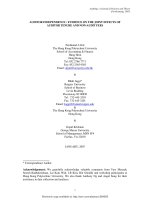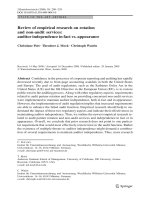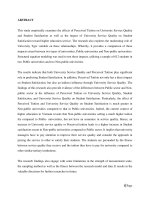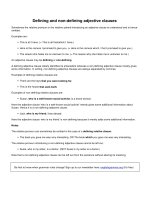Defining and non defining adjective clauses
Bạn đang xem bản rút gọn của tài liệu. Xem và tải ngay bản đầy đủ của tài liệu tại đây (11.6 KB, 1 trang )
Defining and non-defining adjective clauses
Sometimes the relative pronoun or the relative adverb introducing an adjective clause is understood and is hence
omitted.
Examples are:
This is all I have. (= This is all that/which I have.)
Here is the camera I promised to give you. (= Here is the camera which / that I promised to give you.)
The reason she hates me is unknown to me. (= The reason why she hates me is unknown to me.)
An adjective clause may be
defining
or
non-defining
.
A defining adjective clause clearly identifies its antecedent whereas a non-defining adjective clause merely gives
some information. In writing, non-defining adjective clauses are always separated by commas.
Examples of defining relative clauses are:
There are the keys
that you were looking for.
This is the house
that Jack built.
Examples of non-defining relative clauses are:
Susan,
who is a well-known social activist
, is a brave woman.
Here the adjective clause ‘who is a well-known social activist’ merely gives some additional information about
Susan. Hence it is a non-defining adjective clause.
Jack,
who is my friend
, lives abroad.
Here the adjective clause ‘who is my friend’ is non-defining because it merely adds some additional information.
Notes
The relative pronoun can sometimes be omitted in the case of a
defining relative clause.
The book you gave me was very interesting. OR The book
which
you gave me was very interesting.
The relative pronoun introducing a non-defining adjective clause cannot be left out.
Susie, who is my sister, is a doctor. (NOT Susie is my sister is a doctor.)
Note that a non-defining adjective clause can be left out from the sentence without altering its meaning.
Be first to know when grammar rules change! Sign up to our newsletter here: englishgrammar.org (It's free)
Powered by TCPDF (www.tcpdf.org)









